Birds of America
By John James Audubon, F. R. SS. L. & E.
VOLUME VII.



Family
Genus

SLENDER-BILLED GUILLEMOT.
[Marbled Murrelet.]
URIA TOWNSENDII, Aud.
[Brachyramphus marmoratus.]

PLATE CCCCLXXV.--ADULT AND YOUNG.
I have received not less than four specimens of this small Guillemot from
Mr. TOWNSEND, who procured them on the north-west coast of America, not very far
from the mouth of the Columbia river. The changes of colour in birds of this
genus are well known to be considerable; and I have represented two individuals,
supposing one to be an adult, and the other a young bird in its first plumage,
SLENDER-BILLED GUILLEMOT, Uria Townsendii, Aud. Orn. Biog., vol. v, p. 251.
Adult, 10; wing 5 2/12. Young, in autumn, 9 3/4; wing 5 1/12.
Abundant on the north-west coast of America, not far from the Columbia
river.
Adult.
Bill shorter than the head, straight, slender, much compressed, acute.
Upper mandible with the dorsal line convex and declinate, the ridge very narrow,
the sides erect and convex toward the end, the edges sharp and inflected, with a
distinct notch near the tip, which is rather acute and caniculate beneath.
Nostrils medial, narrow near the margin, in the fore parts of the long nasal
sinus, which is feathered. Lower mandible with the angle long and very narrow,
the dorsal line ascending and straight, the sides nearly erect, but convex, the
edges sharp and inflected, the tip very acute.
Head of moderate size, oblong; neck short; body full, depressed; wings
small. Feet placed far behind, very short and slender; tarsus very short,
reticulate; toes slender, with numerous short scutella; the first wanting; the
third or middle toe longest, the inner much shorter than the outer; claws small,
slightly arched, compressed, rather acute.
Plumage very soft, close, blended, rather glossy; feathers of the head very
short, of the back oblong, of the lower parts ovate. Wings small, very narrow,
convex, falcate; first quill longest, second a twelfth of an inch shorter, the
rest rapidly diminishing; secondaries incurved, obliquely rounded. Tail
extremely short, narrow, rounded, of twelve weak, rounded feathers.
Bill black. Feet yellow; claws black. The upper parts are brownish-black,
the feathers of the back terminally margined with light grey; the lower parts,
cheeks, a transverse band on the nape, both eyelids, and a longitudinal band on
each side, formed by some of the scapulars, white, some dusky streaks on the
hind part of the sides, and the lower wing-covert greyish-brown, the larger
tipped with dull white.
Length to end of tail 10 inches; bill along the ridge (8 1/2)/12, along the
edge of lower mandible 1 4/12; wing from flexure 5 2/12; tail 1 4/12; tarsus
8/12; middle toe 1 1/12, its claw (2 1/2)/12.
Young in autumn.
Bill and feet as in the adult. The upper parts are brownish-black, the
feathers terminally margined with brown; the occipital band is merely indicated
by some lighter feathers, and the scapular band is brownish or chestnut-red.
The lower parts have a curious mottled appearance, the feathers being
brownish-grey at the end, but in the rest of their extent white, that colour
appearing more or less on all parts, and shewing a patch on the hind part of the
sides.
Length to end of tail 9 3/4 inches; bill along the ridge (7 1/2)/12, along
the edge of lower mandible 1 3/12; wing from flexure 5 1/12; tail 1 2/12; tarsus
(7 1/2)/12; middle toe 11/12, its claw (2 3/4)/12.
Two other individuals, apparently more advanced, or perhaps adults in
winter, have the upper parts brownish-black; the lower white but finely mottled,
a small portion of the extremity of each feather being greyish-dusky. The white
bands on the hind neck and scapulars are formed, and the lower surface of the
wing is brownish-grey.









